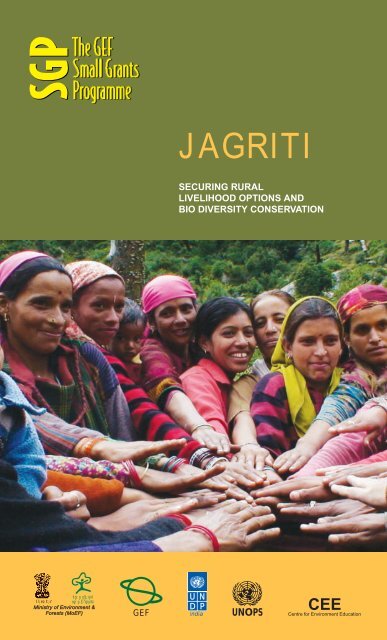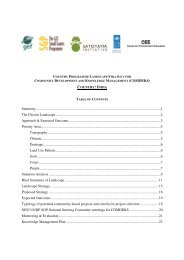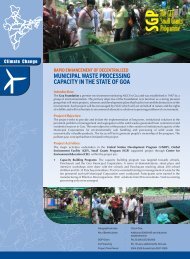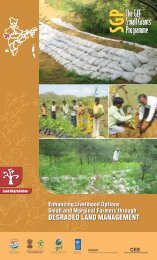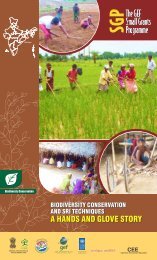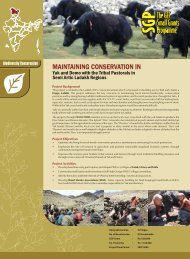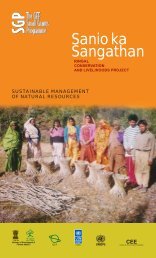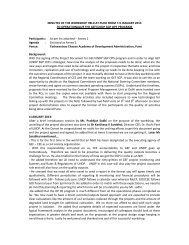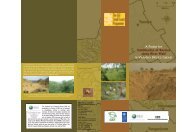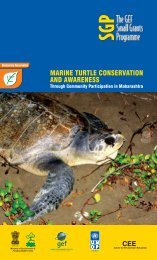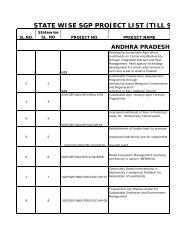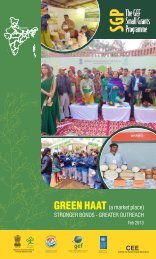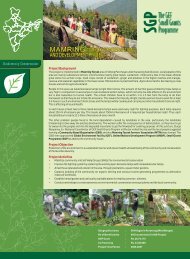JAGRITI
JAGRITI - SGP India
JAGRITI - SGP India
- No tags were found...
Create successful ePaper yourself
Turn your PDF publications into a flip-book with our unique Google optimized e-Paper software.
<strong>JAGRITI</strong><br />
SECURING RURAL<br />
LIVELIHOOD OPTIONS AND<br />
BIO DIVERSITY CONSERVATION<br />
tgk¡ gS gfj;kyhA<br />
lR;eso t;rs ogk¡ gS [kq’kgkyhAA<br />
Ministry of Environment &<br />
Forests (MoEF)<br />
U N<br />
D P<br />
CEE<br />
GEF India UNOPS<br />
Centre for Environment Education
Jagriti, a grassroot level women centered NGO<br />
established in 2003 is working in Kullu and has<br />
initiated the community management climate<br />
change, livelihoods and enterprise development<br />
project in Lag and Gadsa valley of Himachal<br />
Pradesh in India. The village areas are located at<br />
an altitude varying 2000-2700 meters above sea<br />
level. Many of the remote villages like. Manihar<br />
and Thatch have no road connection and are<br />
linked by narrow pathways. The communities<br />
work cohesively with Jagriti.<br />
Geographic area:<br />
4 Panchayats to 2 Districts<br />
(50 villages)<br />
No. of participants:<br />
196 households to 1000<br />
HHS.<br />
SGP Grant: 43,402 USD<br />
Scaled up: 41,000 USD<br />
Cofinancing: 24,000 USD,<br />
54,000 USD.<br />
Time Period: 2004-06-09<br />
Project Objective:<br />
Expand and diversify livelihoods of poor rural women and<br />
raise and conserve high altitude threatened species of<br />
medicinal plants.<br />
Project Rationale:<br />
The Gadsa Valley represents the scattered settlement pattern<br />
on higher altitudes in the Western Himalayas. Deep-rooted<br />
social sanction against scheduled castes has restricted their<br />
settlement to the periphery of villages which usually has<br />
poor, less fertile and smaller land holdings. Harsh climatic<br />
conditions and inaccessibility to basic services impose<br />
greater drudgery and livelihood pressure on poor<br />
households in meeting their needs.
Even within the poor households the burden is much more on women because of the nature of<br />
their activity profile like collecting fuelwood, fodder, grass cutting, grazing cattle, fetching water<br />
etc.<br />
Besides, using resources for own consumption, selling fuelwood, fodder, medicinal plants and<br />
sheep and goat rearing are main sources of income in the Valley. Heavy dependence of poor<br />
households on forest resources for livelihood is contributing to rapid depletion of available<br />
resources like fuelwood in the area. The burden of obtaining resources has increased considerably.<br />
Since women are predominately engaged in these activities, the drudgery and increasing time in<br />
obtaining existing resources has further exaggerated and extended their work burden.<br />
The project strategy has been essentially structured around WSCGs (Women Self Care Groups) and<br />
all activities centered through them, the women members of the community are directly involved<br />
in project implementation. Since the project emphasis is on collective planning and execution of<br />
activities, homogeneity of a group is a crucial factor in ensuring representative decision making<br />
processes within the group. In order to build stake in the project, community contribution both in<br />
kind and in cash has been enlisted thereby lifting myths about cost sharing, money and mindset.<br />
The critical step of demonstrating awareness through action has been the cornerstone of Jagriti,<br />
softly influencing policy making procedures. Gender sensitive budgeting is also being<br />
encouraged in the project.
Project Activities:<br />
Social mobilisation and institution building<br />
Formation of Women's Saving Care Groups (WSCG) was<br />
preceded by a detailed survey based on location specific<br />
indicators of identification of poor households. Record<br />
keeping and group management were key for effective<br />
group functioning. Today more than 30 WSCG, are<br />
functioning having savings of Rs. 5 lacs per annum and<br />
links to banks for credit of another additional Rs. 3 lacs per<br />
annum. More than 1000 women are members in these<br />
groups.<br />
All the group members regularly save on monthly basis<br />
and deposit the same in their respective group account.<br />
Panchayat level meeting of the group members facilitate<br />
inter group learning and sharing of experiences. Training<br />
programmes, workshops, mahila mela forum for<br />
confidence building and effective participation in public<br />
are organised by Jagriti.<br />
Drudgery reducing and time saving technologies<br />
Introduction of energy saving and drudgery reducing<br />
devices namely Hamam (Water heating device) was<br />
distributed to members on cost sharing basis. This has<br />
greatly reduced the time and drudgery for women and<br />
given them greater opportunities.<br />
Enterprise Management<br />
Under the project, a system of procurement of the apricots<br />
and peaches was introduced to ensure quality control.<br />
Indicator at each level has been developed. It was found<br />
some of the products are available in small quantities and<br />
in order to reduce the transaction cost, local collection at<br />
village level and then at the panchayat level provided<br />
monetary benefits to members. Nearly 20,000 kgs of peach<br />
kernals are collected in a season giving nearly 400 litres of<br />
oil and an additional income of Rs. 4 lacs for SHGs. Value addition and marketing of the local<br />
fruits and forest produce collected by the Women's Saving and Credit Groups in the villages is<br />
the hallmark of Jagriti. Amaranthus flour, apple chips, apricot oil and scrub, beeswax cream,<br />
buckwheat flour, corn flour, rosechip herbal tea, roasted barley and soya bean, popped<br />
amaranthus are some of the products from the range of products marketed by Jagriti.<br />
Raise medicinal plants and promote energy plantation:<br />
Conservation of threatened medicinal plants like Aconitum heterophyllum, Picrorhiza kurroa,<br />
Valeriana wallichii, Podophyllum, Dioscorea deltoidae etc by setting up nurseries and making<br />
people aware about the sustainable use of natural resources. This activity is supported by the<br />
PCCF, Forest Deptt. Himachal Pradesh.<br />
Vermicomposting:<br />
Popularizing Vermicompost so as to promote organic farming in the area. For this initial support<br />
was provided by the organization in three areas namely Lag Valley, Gadsa Valley and Jagatsukh.<br />
The result have already started coming in and the total production of vermicompost as per now<br />
in the three regions is 1339, 349 and 120 quintals respectively. Similarly, the production of<br />
Vermiwash is about 365, 91 and 116 litres respectively.
Results and Lessons:<br />
1. 51 WSCGs formed and registered with the Bank with total<br />
savings accumulating to over five lakhs. Intra group loans<br />
to the tune of Rs 94,800.<br />
2. 17 WSCGs having 60 pits engaged in production of<br />
vermicompost. Total production of 1879 quintals of<br />
which, 293.3 quintals used by members in their fields and<br />
remaining sold to big farmers and orchids.<br />
3. 495 hamams (water heating device) distributed to women<br />
members on cost sharing basis. Members contribution to<br />
the tune of Rs. 43,170. More efficient use of household<br />
and agricultural waste for water heating and lesser trips to<br />
forests in summer for fuelwood. Now members have<br />
more time available for other household chores and<br />
leisure and less exposure to indoor pollution. The<br />
ordinary woman's workday here stretches between 16<br />
and 18 hours.<br />
An analysis (carried out by Jagriti in Gadsa valley) of the<br />
activity breakup and hours spent on each activity shows<br />
that time spent on cooking, utensil washing and fuelwood<br />
gathering adds upto a daily total of 6 to 7 hours.<br />
According to the preliminary survey conducted by Jagriti,<br />
in a year an average household roughly uses 15-17<br />
quintals ('00 kg) of fuelwood with bulk of it in winter.
Besides cooking, fuelwood is used for heating of room, water<br />
for bathing and for washing. Average hot water requirement<br />
per day per household in winter months i.e for six months is 50-<br />
60 liters. A comparative study of fuelwood consumption in<br />
traditional chullah as against Hamam suggests that to heat 20<br />
liters of water in a traditional chullah takes roughly 10 -12 kilo<br />
of hard wood and time taken is 35-40 minutes whereas, in<br />
Hamam it takes 2 kilo of household litter, crop residue or small<br />
twigs to heat 20 litres of water in 15-20 minutes. So, with use of<br />
hamam for approximately 130 days in a year, a household<br />
saves 1.5 tons of fuelwood.<br />
4. The project has also introduced energy efficiency devices as<br />
pressure cookers.<br />
5. Women's participation and PRI: WSCG's members are<br />
actively participating in the gram sabha meetings. Earlier<br />
women saw their role as only voters and often could not muster<br />
courage to even attend the gram sabha. According to some of<br />
the women members, gram sabha is mainly attended by men<br />
Gender Sensitive Energy<br />
Benefits<br />
Welfare : Lighten the daily<br />
burden of poor women.<br />
Efficiency : Community<br />
cost sharing developing<br />
interest and local<br />
ownerships of actions.<br />
Poverty : Different income<br />
and enterprise based<br />
actions are impacting<br />
livelihoods.<br />
Meeting Millennium<br />
Development Goals<br />
(MDGs) : Expanding access<br />
to modern energy services<br />
for the poor.<br />
as quorum counting is done on the basis of one vote per household. It has been seen that the<br />
presence of women in large numbers in village level bodies greatly influenced to their ability to<br />
lobby & build collective pressure to push decisions in their interest. Several examples have been<br />
cited in the project on how WSCG's members joint representation at panchayat level has made a<br />
big difference in how decisions are made in the gram sabhas. Thus, as a first step 'even the<br />
presence' of women in good numbers produces a favourable impact.<br />
6. The NGO Jagriti has recently won the SEED Award 2008 for entrepreneurship in sustainable<br />
development: The NGO has also established a marketing outlet on Kullu Manali main road as<br />
"Mountain Bounties". This is linked to the women federations and is marketing a range of<br />
products for a total value of Rs. 20,000 per month. This has provided income and empowerment<br />
for the local women in the area. The NGO is actively linking its products with the Himachal<br />
Pradesh Tourism Department through retail outlets in Simla and Manali.<br />
7. Women play their roles effectively, when involved in the decision making processes and given<br />
opportunities centrally in planning the actions, implementing and monitoring the program.<br />
8. Women see women workers as 'great inspiration' in the program, more so when they are<br />
managing and dealing with financial matters and resources.<br />
<strong>JAGRITI</strong><br />
Ms. Mamta Chander, Director<br />
Village Badah, PO Mohal<br />
District Kullu-175126<br />
Tel.: 0190-2226537 Fax: 92184-74832<br />
Email: info@jagritikullu.org<br />
Website: www.jagritikullu.org<br />
National Co-ordinator<br />
GEF UNDP Small Grant Programe<br />
CEE Delhi,<br />
C-40 South Extension-II,<br />
New Delhi-49 Ph.: 011-26262878-80<br />
E-mail: sgpdelhi@ceeindia.org<br />
www.sgpindia.org<br />
www.ceeindia.org<br />
Colours Advertising 03/09


